10 Scenes From Oracle's America's Cup World Series
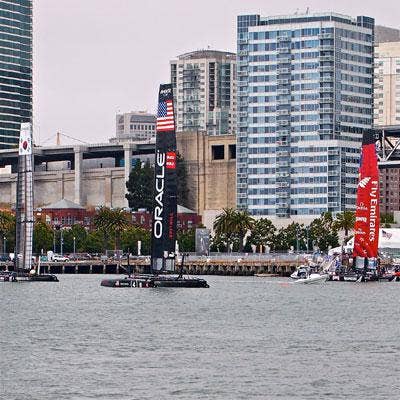
Oracle Team U.S.A. Sails Into The Winner's Circle
Larry Ellison's Oracle Team U.S.A. sailed into the winner's circle in the America's Cup World Series, marking a triumph for both first-place winner Russell Coutts and runner-up Jimmy Spithill as they swept this prelude to the America's Cup championship in September 2013.
From Aug. 21 to 26, eight teams from around the world gathered in San Francisco to compete, including Sweden's Artemis Racing, China Team, Emirates Team New Zealand, France's Energy Team, Great Britain's J.P. Morgan BAR, Italy's Luna Rossa Challenge 2013, Team Korea, and, of course, Oracle Team U.S.A., with Italy, Sweden and the U.S. racing two catamarans each for a total of 11 boats battling for the win.
To kick things off, Oracle invited CRN to an exclusive behind-the-scenes visit, from its top-secret warehouse to boatside seats of the action. Here's a look at 10 scenes from Oracle's America's Cup World Series.
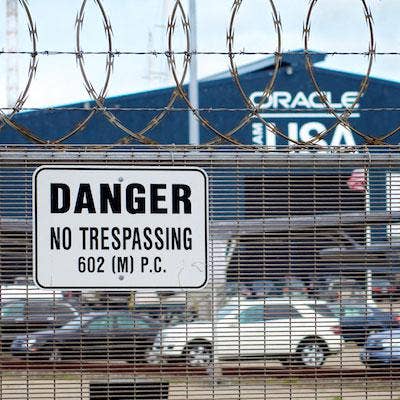
Top Secret
Our tour began at Team Oracle's top-secret warehouse located at San Francisco's Pier 80. The foreboding fence with signs reading "No Trespassing" might seem a bit much -- it felt more like walking into NASA's headquarters. However, the upcoming 2013 America's Cup World Series marks not only a potential gold for the U.S. but also breakthroughs in sailing technology, as Oracle has been paving the way for innovations in the sport.
At the 2010 America's Cup World Series, in which Team Oracle won the gold, it already had begun to change the game by moving from the typical yacht mast to what's called a fixed-wing sail. Bigger than the wing of a Boeing 747 and quite a bit heavier than the sails of old, the fixed-wing sail added not only speed to the vessel but also quite a bit more weight.
"Like plane's wings making the transition for airplanes, wings are a big transition. Now, sailing finally made [that transition]," said tour guide Eduardo Aldaz, a performance analyst for Team Oracle U.S.A.
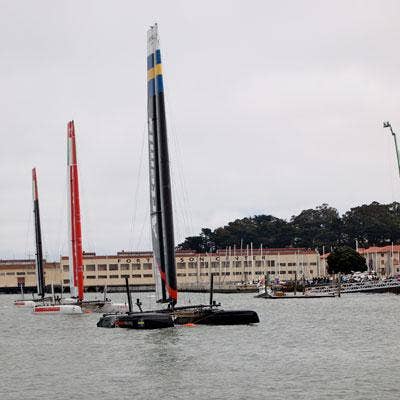
Making Waves
This year, to make that next step in sailing history, Team Oracle has not only moved from a three-hulled vessel to a dual-hulled design but also outfitted the hulls of the catamarans in a durable, lightweight, aerodynamic carbonlike structure, or as Aldaz calls it, a "carbon sandwich" -- a honeycomb-like structure sandwiched between two pieces of carbon. All teams in the America's Cup World Series are using the catamaran design, courtesy of Oracle, which supplied everything except the sail so that teams could have a head start building their own boats for the championship. Three competitors' catamarans, each decked out with dual-hulls, are pictured left.
However, with all of these new designs, Team Oracle had some new challenges to overcome: It had made the boat lighter and faster while precariously balancing an enormously heavy sail. "We expect things to break. ... You want the boat to be as light as possible, but if you go too far, things start breaking," said Aldaz. To meet the rising challenges, it meant upping the technological ante.
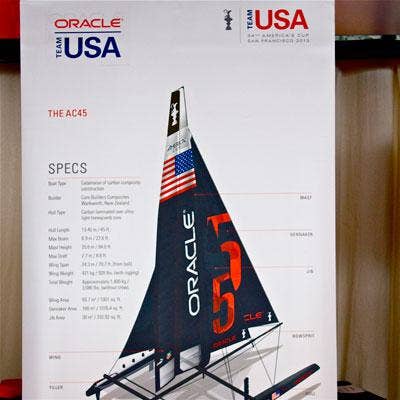
High Tech On The High Seas
There are two types of electronics needed in performance sailing, Aldaz said. The first type is for the sailors, who need "true wind direction and true wind speed," he said. The design team and performance analysts, however, have other needs. "Are the loads real, or am I seeing less?" Aldaz said, referring to the load of pressure being put on the vessel. As such, the boats are rigged with high-tech, fibre-optic sensors running throughout.
With a number of sophisticated gadgets measuring and analyzing every dip and turn, there ends up being a whole lot of information, and each team member has different needs. "There's a lot of data on the boat that we store in a database," Aldaz said, which poses yet again another barrier: The carbon used to make the hull prevents the transmission of wireless data, which meant that there needed to be a way to get that data to the design and performance analysts on shore.
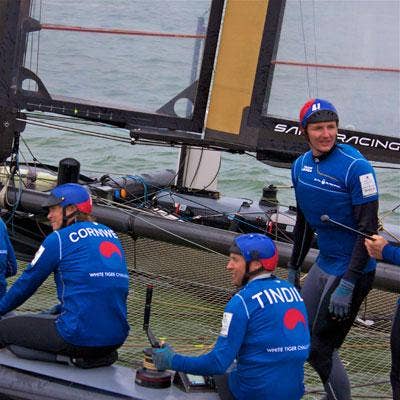
Ruckus Calms The Seas
Getting the boatloads of information from the database to the sailors and the design and performance analysts became the next challenge. Aldaz noted that the "boat has all of the intelligence. The sailors have direct access via screens on board," referring to the six displays on the boat. "What can designers and performance analysis see in realtime? That’s the difficulty," Aldaz said.
To solve this problem, in stepped Ruckus. Ruckus' Smart Wi-Fi technology increases Wi-Fi transmission strength, performance and reliability, so that the signals are continuously adjusted around barriers to the best-performing paths in changing environmental conditions.
"Now everyone has the displays they need," said Aldaz. Each team member is able to access and view only the information pertinent to his or her role, or, alternatively, to view all of the data. What's more, the data is accessible via any number of wireless devices. "It's so cool to see the guys with tablets," Aldaz said.
{C}
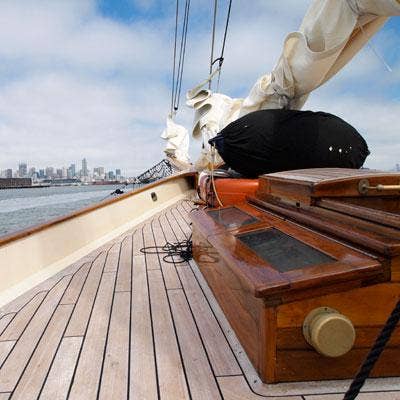
The Race Is On
To put into perspective just how far professional sailing has come, we were escorted aboard a replica of America's 1851 first America's Cup World Series winning yacht. Built in 1995, the historic yacht sailed for two and half days from the San Diego Maritime Museum where it lives most of the year, said crewmembers Michael Ash and Fathom Neft.
Although there was no doubting the beauty of this boat, it most certainly demonstrated that today's professional sailors have come a long way. And, the crew's excitement to be sailing this piece of maritime history to such an event was self-evident. "We've been looking forward to this day for a really long time," announced our captain, Tony Sears, to the crew and passengers just before setting sail.
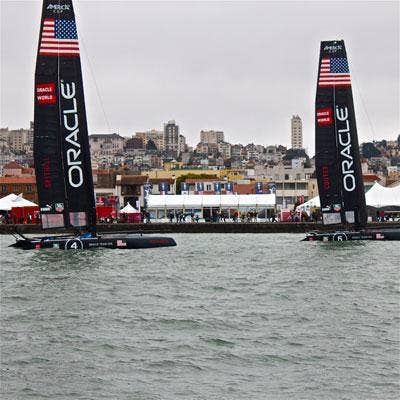
Oracle Village
After a brief stint up the bay, we dropped anchor at San Francisco's Marina Green, an area overlooking the marina and the future home of the America's Cup Village, where Ellison plans to construct a tent village on the sidelines complete with big-screen TVs and ringside seats for the racing action. Stephen Barclay, CEO of the America's Cup Authority, says it will be like "NASCAR on the water."
The white tents along the shore, pictured between the two Oracle boats, give a feel for what the village will look like for the 2013 America's Cup World Series.
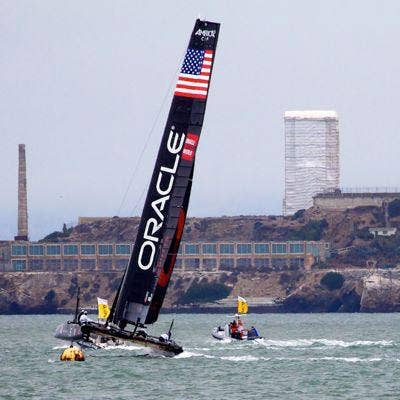
Corners Like It's On Rails
The boats being sailed for the preliminary races are actually 45-foot-long catamarans, speeding across the water at up to 30 knots, roughly 35 mph, with a turning radius that'll blow the socks off most cars. The purpose of the preliminary events is to give "everyone a fair chance to compete" using the new wings, design and technology, Aldaz noted.
Likewise, with the race being hosted in San Francisco, Team Oracle gets a home-team advantage. "The San Francisco Bay is the most spectacular natural amphitheater for sailing," reads a giant quote, attributed to Ellison, in the top-secret warehouse.
However, it is also infamous for its treacherous waters, serving as the home to Alcatraz Prison, deemed ideal for housing dangerous criminals due to the water's depth and powerful tidal currents -- making escape highly unlikely. But, Team Oracle feels up to the challenge. "San Francisco is an awesome place for sailing ... it's got wind, current, everything," Aldaz said.
{C}
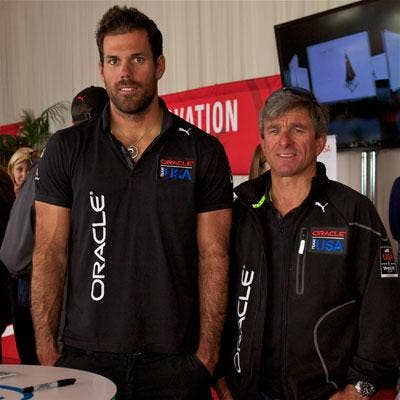
Innovation Lounge
At Oracle's Innovation Lounge, in the soon-to-be Oracle Village, we found Murray Jones, Oracle Team wingsail trimmer, and Shannon Falcone, Oracle Team mast, signing autographs.
Despite all the high-tech advancements, there's no substitute for years on deck. "Murray's been winning cups since before I was born," Falcone (left) said. Having gotten his sea legs when he was only 19 years old, Jones was part of the "original dream team" U.S.A., according to Falcone, and has won four cups.
{C}
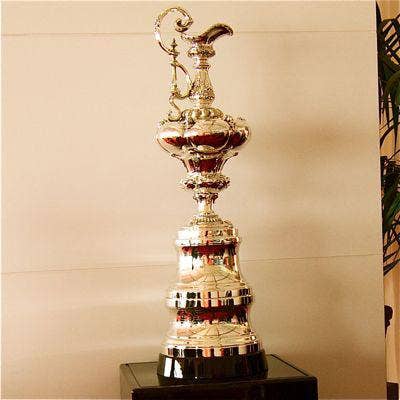
2013 America's Cup World Series, San Francisco
The end goal: bringing home the America’s World Cup Series trophy (left).
The top-secret boat is in its final stages. "We’re doing the finishing details," said Aldaz, adding that it "should be ready in about two weeks." And, in the warehouse where it's stored, there are crews constantly toiling to make certain she's seaworthy and ready to sail in time.